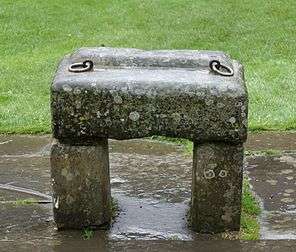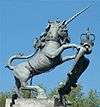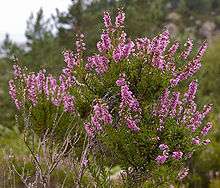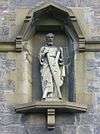National symbols of Scotland
The national symbols of Scotland are flags, icons or cultural expressions that are emblematic, representative or otherwise characteristic of Scotland or Scottish culture. As a rule, these national symbols are cultural icons that have emerged from Scottish folklore and tradition, meaning few have any official status. However, most if not all maintain recognition at a national or international level, and some, such as the Royal Arms of Scotland, have been codified in heraldry, and are established, official and recognised symbols of Scotland.
Flags
 |
The national flag of Scotland, the Saltire or St. Andrew's Cross, dates (at least in legend) from the 9th century, and is thus the oldest national flag still in use. The Saltire now also forms part of the design of the Union Flag. |
.svg.png) |
The Royal Standard of Scotland, a banner showing the Royal Arms of Scotland, is also frequently to be seen, particularly at sporting events involving a Scottish team. Often called the Lion Rampant (after its chief heraldic device), it is technically the property of the monarch and its use by anybody else is illegal, although this is almost universally ignored, and never enforced. |
Heraldry
 |
The Royal Arms of Scotland[1] is a coat of arms symbolising Scotland and the Scottish monarchs. The blazon, or technical description, is "Or, a lion rampant Gules armed and langued Azure within a double tressure flory counter-flory of the second", meaning a red lion with blue tongue and claws on a yellow field and surrounded by a red double royal tressure flory counter-flory device
Although officially subsumed into the heraldry of the British Royal Family in 1707, the historic Royal Arms featuring the lion rampant continues to represent Scotland on several coins of the pound sterling, forms the basis of several emblems of Scottish national sports teams (such as the Scotland national football team),and endures as one of the most recognisable national symbols of Scotland |
.svg.png) |
The thistle, the floral emblem of Scotland, also features in Scottish & British heraldry through symbols, logos, coat of arms and on British currency. |
 |
The Honours of Scotland, the Scottish Crown Jewels, are displayed in the Crown Room of Edinburgh Castle, from where they are removed only for State Occasions. They appear on the royal crest, as well as on the badges of the Royal Regiment of Scotland, Police Scotland, the Scottish Ambulance Service and upon Royal Mail premises, vehicles and pillar/wall boxes in Scotland. |
Anthems
Cultural
Flora and fauna
Food and drink
 |
Haggis is one of Scotland's most recognisable and traditional foods associated annually with Burns' night. |
| |
Irn Bru is Scotland's most popular home-grown soft drink. |
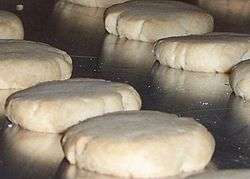 |
Shortbread (bottom left) Shortbread is a classic Scottish dessert that consists of flour, sugar, and butter. |
 |
Whisky is the quintessential drink of Scotland. |
People
See also
References
|
|---|
|
|
|
| History | | |
|---|
|
| Geography | |
|---|
|
| Politics | |
|---|
|
| Economy | |
|---|
|
| Society | |
|---|
|
|
|
|---|
|
| Sovereign states | |
|---|
|
States with limited
recognition |
- Abkhazia
- Kosovo
- Nagorno-Karabakh
- Northern Cyprus
- South Ossetia
- Transnistria
|
|---|
|
Dependencies and
other territories |
- Åland
- Faroe Islands
- Gibraltar
- Guernsey
- Isle of Man
- Jersey
- Svalbard
|
|---|
|
| Other entities | |
|---|

.svg.png)

.svg.png)


